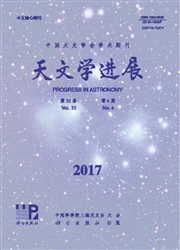

 中文摘要:
中文摘要:
太阳过渡区是位于色球与日冕之间的一个高度动态的等离子体区域。通过对太阳紫外光谱的研究发现,过渡区的主要结构是以磁场集中为特征的网络组织。首先回顾太阳过渡区的研究历史,接着从整体上介绍太阳过渡区的结构及观测特征,然后介绍过渡区各种结构和现象的主要模型和物理解释,并结合作者的认识进行必要的评论,最后对未来的研究方向提出看法。
 英文摘要:
英文摘要:
The solar transition region, in which above the photosphere the temperature increases rapidly and the density drops dramatically, is a rather inhomogeneous and dynamic layer between the chromosphere and corona. The transition region is believed to play an important role in the origin of the solar wind and in coronal heating. The most prominent feature in the transition region is the network structure, which is the upward extension of the supergranular boundary above the photosphere and manifests itself as bright lanes on the radiance images of FUV/EUV lines. It is believed that the network fluxes consist of two components: the magnetic funnel, either open into the corona and guiding the solar wind or being simply the leg of a large coronal loop, and low-lying flux ropes in the rest of the network. Most of the FUV/EUV emission lines formed in the middle transition region show a predominant red Shift, which can be caused by the return of spicule materials, siphon flows driven by asymmetric heating through loops, nano-flares and the resulting downward propagating waves, or downward flows after magnetic reconnection between open field lines and closed loops at the upper transition region in the network. While for lines formed in the upper transition region and lower corona, a net blue shift is found, which is believed to be associated with the nascent solar wind outflow. Lots of transient phenomena are found in the transition region, including blinkers, explosive events, micro/nano flares, coronal bright points, and spicules. Blinkers are transient brightenings with a life time of 3-110 minutes and caused by a process which can lead to the increase of density or filling factor of the transition region. Explosive events correspond to outflows (at the order of 100 km/s) in magnetic reconnection. Micro/nano flares are believed to play a very important role in heating the corona. Coronal bright points are local heating phenomena occurring in the transition region and lower corona, the related powering could be due
 同期刊论文项目
同期刊论文项目
 同项目期刊论文
同项目期刊论文
 Horizontal supergranule-scale motions inferred from TRACE ultraviolet observations of the chromosphe
Horizontal supergranule-scale motions inferred from TRACE ultraviolet observations of the chromosphe Upward propagating high-frequency Alfvén waves as identified from dynamic wave-like spicules observe
Upward propagating high-frequency Alfvén waves as identified from dynamic wave-like spicules observe Reconfiguration of the coronal magnetic field by means of reconnection driven by photospheric magnet
Reconfiguration of the coronal magnetic field by means of reconnection driven by photospheric magnet 期刊信息
期刊信息
